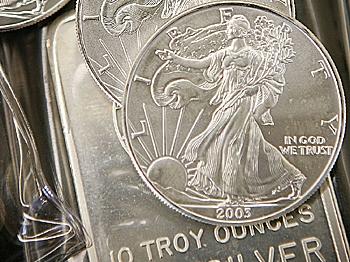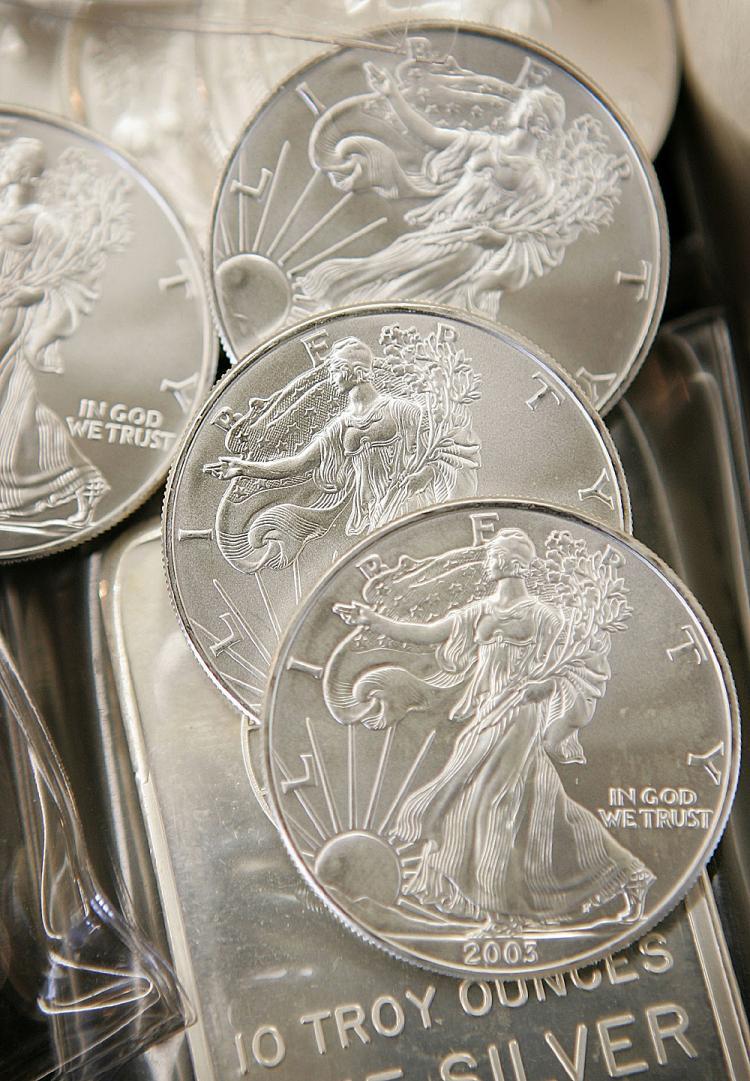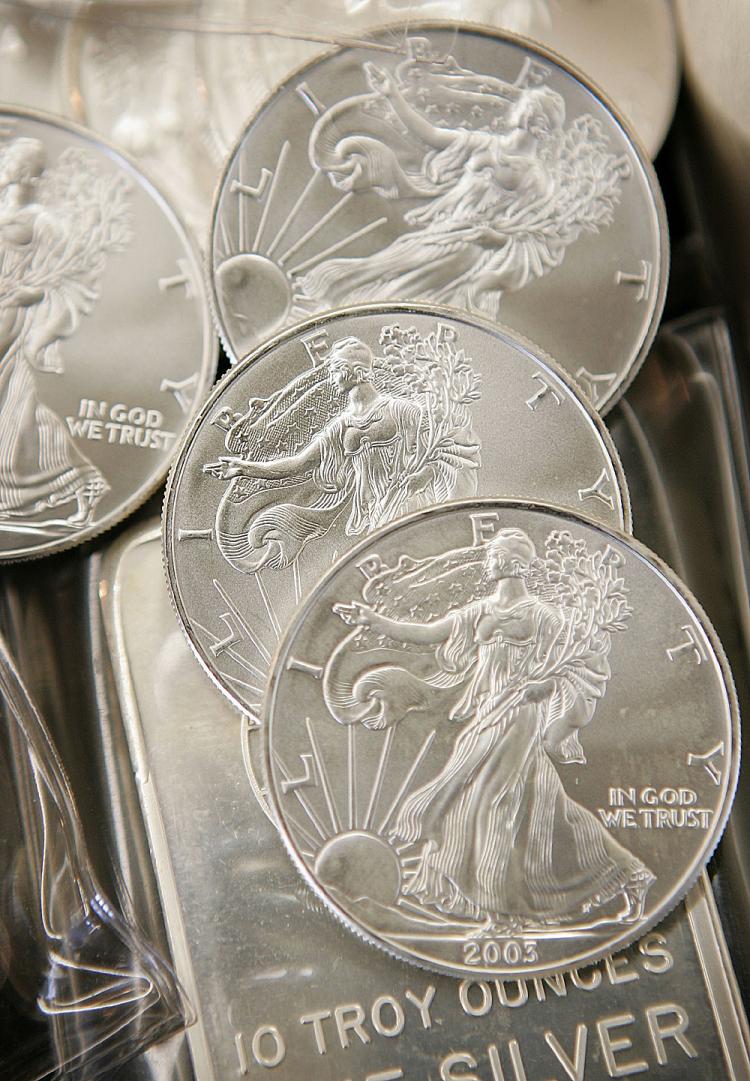WASHINGTON—The price of silver has risen 188.7 percent over the last 10 years. And over the last year, it has outperformed gold despite far less publicity.
The price of silver was $6 per ounce in December 1999 and remained almost static until January 2004. Silver peaked in 2008 at $21 per ounce and dropped to $9 per ounce by the end of 2008. In 2009, silver price steadily rose and is now hovering between $17 and $18.
“Silver broke through the $19/oz level on 2nd December, at which point it was a remarkable 102% higher year-on-year. This is far better than gold (55%) managed over the same 12 months, or even platinum (83%),” according to CommodityOnline India Limited, a research and consulting firm.
The Hennessee Group, an advisory firm to hedge fund investors, argues that silver’s market price could be undervalued when compared to gold, and it predicts an upward trend in the value of silver.
“While we see both gold and silver as safe haven investments, particularly as a hedge against the longer term risk of hyper-inflation, we believe gains in silver will outpace gold,” advised Charles Gradante, co-founder of the Hennessee Group, in a statement.
Silver could reach new heights in early 2010, reaching around $22 per ounce, predicted Roger Wiegand, bullion trader and editor of the Trader Tracks Newsletter, in December.
CommodityOnline disagrees with the positive outlook held by a large number of trading and research firms. CommodityOnline suggests that the silver prices should be lowered despite strong investor interest, especially since industrial and traditional production is still not up to pre-crisis levels.
BNP Paribas Fortis metals monthly suggested in its December 2009 edition that silver would outperform gold price increases given silver’s industrial and traditional demand potential. The short-term financial crisis is holding silver in a waiting mode, as people are more attuned to hoarding gold than silver.
“Silver’s long-term future, we believe, rests on new industrial applications, and these are much more likely to happen in a recovering economy rather than a depressed one. In the meanwhile, the silver price will take its cues from gold as seen on 4th December, when it plunged along with the yellow metal back to $18/oz,” according to a BNP Paribas analysis.
Most commodities investors don’t own actual gold or silver bullions, as there are risks of security, storage, and liquidity. Many investors instead buy exchange-traded funds (ETFs), which seek to mimic the performance of the metals.
The “iShares Silver Trust, created in 2006, has grown in popularity in recent years and has led to tremendous growth in the amount of silver backing the shares issued to investors. Growth in the silver ETF market is likely to continue going forward and will put additional strains on the supply/demand dynamics for silver,” forecasts the Hennessee Group.
The iShare Silver Trust value on Dec.17 was $16.87, based on information from the New York Stock Exchange. The value fluctuated between $16 and $18 throughout 2009. The value of the trust reflects at all times the price of silver in possession by the trust, less the trust’s expenses.
An ETF is similar to a mutual fund and allows investors to be part of the silver market through trading in the security market. ETF shares can be traded whenever stock exchanges are open. The stock will be traded at the net asset value of the underlying asset. An ETF may buy silver or any other type of commodity in the market and holds it in custody. The trust issues common shares at a given conversion rate, which are then sold to investors who hold a percentage of the commodity.
Barclays Global Investors International Inc. was the first to set up a silver iShares fund with 1.5 million ounces of silver in the trust. The Barclay iShares Silver Trust presently holds more than 140 million ounces in custody.
The JPMorgan Chase/Mellon iShares prospectus, published Dec. 1, is transparent to a fault, warning the prospective shareholder of significant risks.
“The supply side of silver is unique as well in that only a small percentage of mines in the world are pure silver producers, rather silver is typically a by-product of mines mainly engaged in extracting lead, zinc and copper,” according to the Hennessee Group.
According to the Silver Institute Web site, a total of 888.4 million ounces of silver was produced through mining, from old silver scrap, and through government sales in 2008. Silver mine production increased by 2.5 percent in 2008, with Peru (118.3 million ounces) being the biggest silver producing country. Mexico (104.2 million ounces), China (82.8 million ounces), Australia (61.9 million ounces), and Chile (44.9 million ounces) ranked behind Peru in silver production.
In 2008, industrial applications consumed 447.2 million ounces of silver, while traditional uses—such as in jewelry, coins, and silverware—consumed 385.3 million ounces.
“Diversity is silver’s primary asset. Its unique properties include beauty, strength, sensitivity to light, malleability and ductility, electrical and thermal conductivity, reflectivity and the ability to endure extreme temperature changes. These properties allow groundbreaking research to be conducted by scientists and engineers that effect [sic] the way we live,” according to the Northwest Territorial Mint Web site.
The price of silver was $6 per ounce in December 1999 and remained almost static until January 2004. Silver peaked in 2008 at $21 per ounce and dropped to $9 per ounce by the end of 2008. In 2009, silver price steadily rose and is now hovering between $17 and $18.
“Silver broke through the $19/oz level on 2nd December, at which point it was a remarkable 102% higher year-on-year. This is far better than gold (55%) managed over the same 12 months, or even platinum (83%),” according to CommodityOnline India Limited, a research and consulting firm.
The Hennessee Group, an advisory firm to hedge fund investors, argues that silver’s market price could be undervalued when compared to gold, and it predicts an upward trend in the value of silver.
“While we see both gold and silver as safe haven investments, particularly as a hedge against the longer term risk of hyper-inflation, we believe gains in silver will outpace gold,” advised Charles Gradante, co-founder of the Hennessee Group, in a statement.
Silver could reach new heights in early 2010, reaching around $22 per ounce, predicted Roger Wiegand, bullion trader and editor of the Trader Tracks Newsletter, in December.
CommodityOnline disagrees with the positive outlook held by a large number of trading and research firms. CommodityOnline suggests that the silver prices should be lowered despite strong investor interest, especially since industrial and traditional production is still not up to pre-crisis levels.
BNP Paribas Fortis metals monthly suggested in its December 2009 edition that silver would outperform gold price increases given silver’s industrial and traditional demand potential. The short-term financial crisis is holding silver in a waiting mode, as people are more attuned to hoarding gold than silver.
“Silver’s long-term future, we believe, rests on new industrial applications, and these are much more likely to happen in a recovering economy rather than a depressed one. In the meanwhile, the silver price will take its cues from gold as seen on 4th December, when it plunged along with the yellow metal back to $18/oz,” according to a BNP Paribas analysis.
Silver ETFs
Most commodities investors don’t own actual gold or silver bullions, as there are risks of security, storage, and liquidity. Many investors instead buy exchange-traded funds (ETFs), which seek to mimic the performance of the metals.
The “iShares Silver Trust, created in 2006, has grown in popularity in recent years and has led to tremendous growth in the amount of silver backing the shares issued to investors. Growth in the silver ETF market is likely to continue going forward and will put additional strains on the supply/demand dynamics for silver,” forecasts the Hennessee Group.
The iShare Silver Trust value on Dec.17 was $16.87, based on information from the New York Stock Exchange. The value fluctuated between $16 and $18 throughout 2009. The value of the trust reflects at all times the price of silver in possession by the trust, less the trust’s expenses.
An ETF is similar to a mutual fund and allows investors to be part of the silver market through trading in the security market. ETF shares can be traded whenever stock exchanges are open. The stock will be traded at the net asset value of the underlying asset. An ETF may buy silver or any other type of commodity in the market and holds it in custody. The trust issues common shares at a given conversion rate, which are then sold to investors who hold a percentage of the commodity.
Barclays Global Investors International Inc. was the first to set up a silver iShares fund with 1.5 million ounces of silver in the trust. The Barclay iShares Silver Trust presently holds more than 140 million ounces in custody.
The JPMorgan Chase/Mellon iShares prospectus, published Dec. 1, is transparent to a fault, warning the prospective shareholder of significant risks.
World Silver Demand and Supply
“The supply side of silver is unique as well in that only a small percentage of mines in the world are pure silver producers, rather silver is typically a by-product of mines mainly engaged in extracting lead, zinc and copper,” according to the Hennessee Group.
According to the Silver Institute Web site, a total of 888.4 million ounces of silver was produced through mining, from old silver scrap, and through government sales in 2008. Silver mine production increased by 2.5 percent in 2008, with Peru (118.3 million ounces) being the biggest silver producing country. Mexico (104.2 million ounces), China (82.8 million ounces), Australia (61.9 million ounces), and Chile (44.9 million ounces) ranked behind Peru in silver production.
In 2008, industrial applications consumed 447.2 million ounces of silver, while traditional uses—such as in jewelry, coins, and silverware—consumed 385.3 million ounces.
“Diversity is silver’s primary asset. Its unique properties include beauty, strength, sensitivity to light, malleability and ductility, electrical and thermal conductivity, reflectivity and the ability to endure extreme temperature changes. These properties allow groundbreaking research to be conducted by scientists and engineers that effect [sic] the way we live,” according to the Northwest Territorial Mint Web site.







Friends Read Free